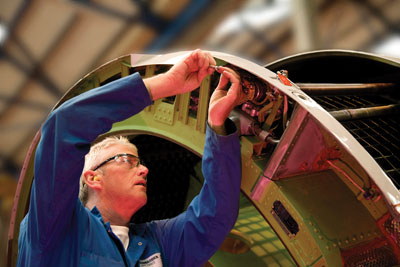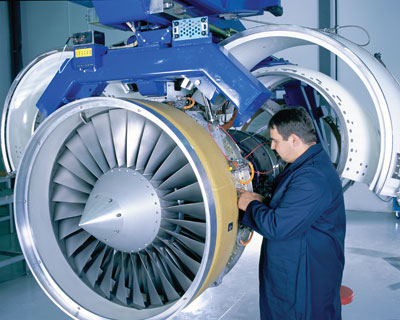
Features
MRO
The Skill Quotient
Aviation maintenance, repair and overhaul (MRO) is on a rebound.
September 26, 2011 By David Carr
Aviation maintenance, repair and overhaul (MRO) is on a rebound. Oliver Wyman, a global management consultancy, estimates that between 2010 and 2014 the MRO market will grow worldwide from roughly $41.5 billion to just over $50 billion, sparked by a post-recession bounce, tightening capacity among larger MROs and a significant increase in the outsourcing of engine overhaul, which represents a 35 per cent slice of all aircraft maintenance.
 |
|
| Larger aerospace players such as Bombardier Aerospace have a steady pipeline of skilled workers to keep production moving. Photo: Bombardier
|
Over that same period, Canada, the United States and Europe are expected to experience a combined dip in global market share from 62 per cent to 57 per cent as price sensitive basic maintenance shifts to lower wage countries, and MROs in emerging markets in Asia, South America and the Middle East continue to post strong growth. According to AeroStrategy, a global aviation consultancy, the fastest-growing region for MRO is the Middle East at approximately 12 per cent.
Interestingly, it is an evaporating talent pool rather than a soaring loonie that threatens Canadian MRO, especially as new-generation aircraft drive growing demand for the types of skills that have traditionally given Canadian shops an advantage. At a recent industry consultation put on by the Canadian Aviation Council for Aviation and Aerospace (CCAA, formerly the Canadian Aviation Maintenance Council), attracting and retaining people with the right skills was the top issue among MRO operators. “A strong dollar is a concern but we can overcome that,” Robert Donald, executive director of the CCAA, points out. “But it doesn’t matter where the dollar is if you don’t have the right people.”
By 2017, 40 per cent of the Canadian labour force will be over 55 years of age and considering retirement, including the more than 80,000 aviation maintenance engineers (AME). Perhaps Canadian MRO dodged a bullet during the recent downturn as demand weakened and the monetary meltdown caused older AMEs to postpone retirement. The current economic crisis and the elimination of mandatory retirement in provinces such as British Columbia, Ontario and Saskatchewan may prompt a similar rethink.
“That can only take you so far,” says Les Aalders, executive vice-president of the Aerospace Industries Association of Canada. “At some point these people are going to have to retire and it is going to be a wave crashing against the bow.” Currently the greatest demand and greatest shortages are for avionics technicians and qualified machinists.
Adding to the frustration is the skills imbalance in the Canadian labour force. In 2011, Canada had a shortage of 560,000 skilled workers versus a surplus of 88,000 unskilled workers. By 2016, an already yawning gap is expected to widen to a shortage of 1.4 million skilled workers versus a surplus of over half a million unskilled workers.
 |
|
| StandardAero is working with the Manitoba government and local schools to ensure the pipeline of skilled workers remains strong.
|
As the retirement clock keeps ticking down the number of students enrolling in aviation maintenance programs is not keeping pace with the 5.2 per cent compound annual growth rate in MRO forecast by Oliver Wyman. Furthermore, there is no guarantee that those who graduate will follow the string onto the floor of an airline, MRO or original equipment manufacturer (OEM). In 2009, 100 per cent of British Columbia Institute of Technology aviation graduates bypassed aviation entirely to work on Vancouver’s Skytrain light rail transit system. Graduates from similar programs across the country are finding higher-paying jobs in the oil patch, bus companies or the ups and downs of elevator repair.
CCAA’s Donald argues that the upcoming skills shortage is going to be markedly different from the shortages of the past. “There is a pipeline effect. Larger players like Air Canada, Bombardier and Aveos [formerly Air Canada Technical Services] had a steady pipeline to the skills they needed leaving smaller operations to struggle. This shortage is going to flow up the pipeline and it is going to hit everybody.”
Aalders agrees. “We are already starting to see individual examples of that.” Bombardier Aerospace is hiring 1,500 new engineers and trades people, and had to send a recruiting team to the United Kingdom and France. One position took two years to fill.
Ironically, it is the cluster of heavy-hitters like Bombardier (the third largest civil aircraft manufacturer), Pratt & Whitney Canada (the largest supplier of engines for regional and business aircraft and helicopters) and CAE (a world leader in simulation and modeling) that will have the greatest need. The knock on effect of this cluster is huge says Aalders. “These companies are generating work in Canada to maintain their products.”
The picture is not all gloom. Some MROs such as StandardAero are not waiting for recruits to walk through the hangar door. The Winnipeg-based MRO has been twisting the spanner on aero engines for almost as long as Canadians have been piloting airplanes (see, “Setting the Standard,” page 51) is playing a larger role in the education system, working with the Manitoba government and local schools to identify the skills to service larger fleets of increasingly more complex airframes, engines and avionics.
Next-generation aircraft, carbon composites and more complex systems will also rekindle an interest in aviation.
But Canada also needs to do a better job of attracting foreign AMEs and fast-tracking accreditation. The number of foreign trained AMEs contributing to the unskilled shortage by driving cabs and sweeping floors is not as severe as with other professions, but they do exist and in increasing numbers. There is also a concern that federal budget cuts might compromise Human Resources and Skills Development Canada’s ability to help the MRO industry solve the skills puzzle.
A simple straight-line analysis points to at least 32,000 Canadian AMEs (40 per cent of supply) set to retire over the next 10 years. For the most part, the Canadian MRO industry has been lucky. Despite an enormous talent bank, offshore operators have been slow to poach Canadian AMEs the same way they do pilots, and foreign students who have trained here are just as likely to stay. But Canada is not the only country confronting a tightening MRO labour market, a situation that makes foreign AMEs more difficult to attract and Canadian AMEs more vulnerable to lure.
It is entirely possible that a sharp increase in jet fuel prices and a depressed market could knock the fragile recovery off course and push the bottom of the skills shortage into the future. But that is a dangerous assumption that few MROs should base their calculations on.
| Setting the standard StandardAero is celebrating 100 years of excellence Dubai’s $15 billion road map into aerospace manufacturing and aviation services runs through Canada. Launched in 2006 by the emirate government, Dubai Aerospace Enterprise’s (DAE) early focus was to be on new airport development and management, especially in China and India. One year later, DAE made a $1.9 billion acquisition into North America, buying Winnipeg-based StandardAero and Arizona-based Landmark Aviation from the Carlyle Group, a global asset management company. Celebrating 100 years, Standard- Aero was an early pioneer in third-party aero engine maintenance and repair. In 1911, two years after John McCurdy first flew the Silver Dart over Baddeck Bay, Nova Scotia, Charles Pearce and William Bickell founded Standard Machine Works, specializing in car, truck and tractor engine repair. In 1936, the company expanded into aircraft engines, beginning with the rebuilding of a British Armstrong Siddeley Cheetah piston engine that would power training aircraft in the Second World War. StandardAero has changed hands several times over the decades and head office has strayed a bit from its Winnipeg roots. DAE consolidated its North American operations under the StandardAero banner. Headquartered in Temple, Ariz., the entity is one of the world’s largest independent providers of MRO services, which include engine and airframe repair and overhaul, engine component repair, engineering services, interior completions and paint for the business, airline and military sectors. In 2010, the Reuters news agency reported that DAE had retained the services of Deutsche Bank to advise on the sale of StandardAero after the company had received interest from several potential buyers. StandardAero quickly denied the story, although Dubai’s state-owned enterprises continue to cope with a $100 billion debt pile and merger and acquisition within global MRO is expected to ramp up after three years of little activity. Whatever the outcome, Standard- Aero’s Winnipeg operation continues to jump from strength to strength. Later this year, the company will cut the ribbon on a $50-million engine testing plant in partnership with GE Canada. |